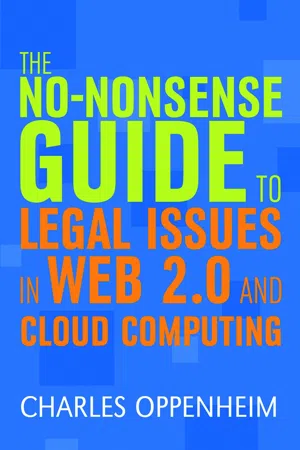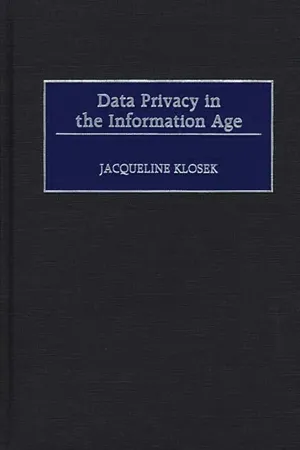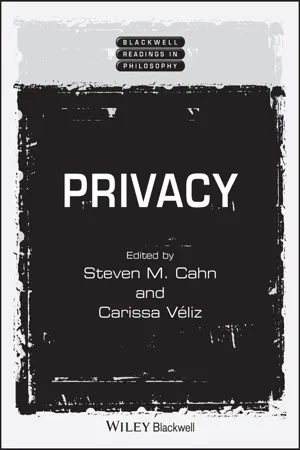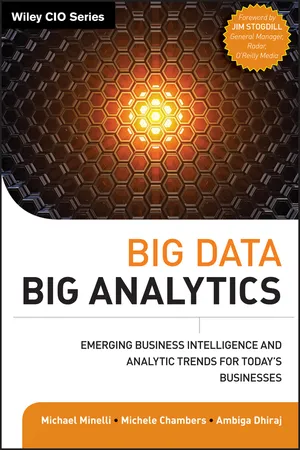Computer Science
Data Privacy
Data privacy refers to the protection of personal information and the right to control how data is collected, used, and shared. In the digital realm, it involves safeguarding sensitive data from unauthorized access, ensuring compliance with privacy regulations, and implementing security measures to prevent data breaches. Maintaining data privacy is essential for building trust and maintaining ethical standards in the handling of personal information.
Written by Perlego with AI-assistance
Related key terms
1 of 5
10 Key excerpts on "Data Privacy"
- Charles Oppenheim(Author)
- 2012(Publication Date)
- Facet Publishing(Publisher)
CHAPTER 4 Data protection and privacy Introduction Most developed countries have at least a minimum level of data protection legislation in place; the USA is notable in having only limited protection at a federal level, although many states have introduced such legislation. On the one hand, everyone should have the right to freedom of expression, the freedom to hold opinions and to impart information and ideas without justified interference. On the other hand, every individual has the right to privacy – to be left alone. These two worthy concepts can, and do, sometimes collide. Typically, a data protection law requires the following: • Data controllers (those who manipulate data about individuals) must register with a supervisory body if they currently, or plan to, use personal data, and if that data can be searched or manipulated using the individual’s name (or some code equivalent) as the search key. • Data subjects (the individuals who have data about them stored and manipulated by third parties – every one of us) have the right to inspect what information is held about them. • Data subjects have the right to demand to know whether data is held about them. • Data subjects can sue for damage caused by inaccurate data about them, or for other breaches, such as unauthorized release of such data. • Data controllers must abide by certain general principles and codes of practice. • No doubt there would be exemptions for matters of national security, crime prevention and so on. • There must be systems in place to prevent unauthorized access, deletion or amendment of records containing personal data. However, some countries’ legislation goes much further, for example, stating that:- eBook - ePub
Genetic Privacy: An Evaluation Of The Ethical And Legal Landscape
An Evaluation of the Ethical and Legal Landscape
- Terry Sheung-Hung Kaan, Calvin Wai-Loon Ho(Authors)
- 2013(Publication Date)
- ICP(Publisher)
I shall then contrast the severe consequences these fundamental difficulties have had for medical and research practice, and for public policies that bear on or use medical or research data, with their apparently un-problematic use in commerce. Finally I shall contrast the idea of data protection, which seeks to regulate informational or communicative content, with older approaches to the protection of informational privacy, which sought to regulate communicative action, by which content of whatever sort is imparted to others. I conclude that the aim of distinguishing personal from non-personal content has proved elusive, and may be impossible, and that data protection approaches to protecting personal informational privacy will remain insecure, however detailed and rigorous we seek to make them. By contrast, approaches to protecting privacy that seek to regulate communicative action do not founder on these difficulties — they may, of course, face other problems. PERSONAL DATA UK data protection legislation aims to secure informational privacy by regulating the processing of specific types of information that are seen as intrinsically personal, or in some cases as both personal and sensitive. It places obligations on those who hold the relevant type of information (data controllers) and assigns legal rights to those to whom the relevant type of information pertains (data subjects). 4 In effect, the UK Data Protection Act 1998 (DPA) seeks to construe informational privacy as a matter of individuals having rights to control their personal information, even when legitimately held by others for specific purposes, by prohibiting its processing for purposes to which they do not consent, unless there are special reasons for setting aside demands for prior consent (e.g - Virginia Dressler(Author)
- 2022(Publication Date)
- Springer(Publisher)
The act required that personal information cannot be used for a different purpose without notice to the subject and the subject’s consent. There are elements that hit on privacy issues within other laws, policies, and clauses that address varying degrees of privacy and privacy infor- 1.3 PRIVACY: MAIN CONCEPTS AND OVERVIEW 10 1. FRAMING PRIVACY WITHIN DIGITAL COLLECTIONS mation, such as Family Educational Rights and Privacy Act (FERPA) of 1974, Health Insurance Portability and Accountability Act (HIPPA) of 1996, Video Privacy Protection Act (VCPA) of 1988, Electronic Communications Privacy Act of 1986 (ECPA), Telephone Consumer Protection Act (TCPA) of 1991, Driver’s Privacy Protection Act (DPPA) of 1994, Children’s Online Privacy Protection Act (COPPA) of 1998, and the Gramm-Leach-Bliley Act (GLB) of 1999. Outside of the U.S., we can see more work on protecting the individual citizen through dif- ferent data protection laws. In the United Nations, there has been work on this issue from the 2016 General Assembly publication of “The Right to privacy in the digital age: resolution,” A/RES/68/167 (U.N. General Assembly, 2016). The European Union also have more coverage on this topic under the data protection directives mentioned earlier, and likewise Canada has multiple privacy statutes (both federal and regional) addressing personal information and data protection (The Federal Per- sonal Information Protection and Electronic Documents Act (PIPEDA); Alberta’s Personal Infor- mation Protection Act; British Columbia’s Personal Information Protection Act; and Québec’s An Act Respecting the Protection of Personal Information in the Private Sector—collectively, Canadian Privacy Statutes. In Europe and Canada, these specific laws have addressed the factors present in a digital society and largely serve to protect individuals from potential privacy violations.- eBook - PDF
Big Data, Big Analytics
Emerging Business Intelligence and Analytic Trends for Today's Businesses
- Michael Minelli, Michele Chambers, Ambiga Dhiraj(Authors)
- 2012(Publication Date)
- Wiley(Publisher)
In 1998, the United Kingdom established the Data Protection Act, which very specifically addresses issues of personal and sensitive data and which is overseen and enforced by a Data Protection Commissioner. This was the United Kingdom’s response to the EU’s 1995 Data Protection Directive. As suggested by Andrew Reiskind in the previous section, companies that operate globally have a lot of unexpected implications to consider, includ- ing and especially cultural ones. We might not consider how factors of daily human exchange play into such differences, such as lower-income environ- ments in which entire families share a cell phone (not unlike the way people shared a single household landline). Their sense of privacy and where they draw boundaries is entirely different to situations where each family member has one or more personal mobile device. These are contextual factors—factors that affect perceptions of privacy. Whether global or local our contexts are constantly changing. Individuals Table 7.2 Types of Protected Information Personally Identifiable Information (PII): any information that directly or indirectly identifies a person Sensitive Information: any information whose unauthorized disclosure could be embarrassing or detrimental to the individual Other Information: any other nonidentifiable information about an individual when combined with PII Name Postal address Email address Telephone/mobile number Social Security Number Driver’s license number Bank/financial account Credit or debit card number ZIP Code Race/ethnicity Political opinions Religious/philosophical beliefs Trade union membership Health/medical information Marital status/sexual life Age Gender Criminal record Preferences Cookie ID Static IP address 160 BIG DATA, BIG ANALYTICS inherently adopt different postures of trust and willingness to share depend- ing on those contexts. What we share in one context we might clearly object to being shared in another. - eBook - PDF
- Jacqueline Klosek(Author)
- 2000(Publication Date)
- Praeger(Publisher)
In fact, there are a number of important similarities between the two systems, the most important of which is the intent to protect the privacy of personal data. NOTES 1. Remarks of Secretary of Commerce William M. Daley, February 5, 1999, available at . 2. Directive 95/46/EC of the European Parliament and of the Council on the Protection of Individuals With Regard to the Processing of Personal Data and on the Free Movement of Such Data of 24 October 1995, OJ L281/31, 23.11.95. 3. Id. at Article 25(1), which provides: The Member States shall provide that the transfer of personal data which are undergoing processing or are intended for processing after transfer may take place only if, without prejudice to compliance with the national provisions adopted pursuant to the other provisions of this Directive, the third country in question ensures an adequate level of protection. Page 6 This page intentionally left blank. Page 7 Chapter 2 Introduction to Concerns about the Protection of Personal Data and the Possible Responses Thereto WHY DO CONCERNS ABOUT PRIVACY AND DATA PROTECTION APPEAR TO BE INCREASING? The Influence of Technology Concerns about the protection of the privacy of personal information are nothing new. For as long as there have been means for transferring and distributing personal data, individuals have been concerned about the possibility that their personal data would be misused or even abused. It is likely, because of these concerns and with the potential harm that abuses of personal data can cause, that the laws of many countries have recognized the individual’s right to privacy in his or her personal data. Indeed, in the United States, the legal recognition of a right to privacy can be traced back to an 1890 Harvard Law Review article entitled ‘‘The Right to Privacy,” by Louis Brandeis and Samuel Warren. - eBook - ePub
- Steven M. Cahn, Carissa Veliz(Authors)
- 2023(Publication Date)
- Wiley-Blackwell(Publisher)
12 Governing Privacy Carissa VélizThis chapter explores what is privacy, why is it important, for whom it is important, and how we can better protect it.Section I offers what I call the hybrid account of privacy, according to which having privacy amounts to being personally unaccessed, and enjoying the right to privacy amounts to not losing control involuntarily over one’s personal information or sensorial space. Section II offers an explanation of why privacy is important: because it shields citizens from harms that arise from exposure to others. Section III explores for whom privacy is important: for individuals and for collectives. Section IV sketches some ideas regarding how we can better protect privacy in the context of artificial intelligence (AI). I will argue for data minimization, storage limitation, and banning the trade in personal data. I end the chapter with some thoughts on the role of consent.I. What is Privacy and the Right to Privacy?
In the digital age, you are losing privacy every day. As you walk the streets of your city, cameras capture your face and may even employ facial and emotional recognition on it. Your phone is being tracked for commercial and security purposes. Your browsing history, your purchasing records, and even your health data is being sold in the data economy. Governments and thousands of corporations may know more about you than most people to which you have a personal connection.Philosophical accounts of privacy can broadly be divided into access and control theories.1 Most scholars who defend access theories of privacy define privacy as a matter of information being inaccessible or of limited access.2 According to such views, you lose privacy when your personal information (or some other element that privacy is supposed to protect) becomes accessible to others. In contrast, according to control theories, you lose privacy when you lose control over your personal information (or some other element that privacy is supposed to protect). The philosopher Andrei Marmor, for example, has argued that “the underlying interest protected by the right to privacy is the interest in having a reasonable measure of control over ways you present yourself to others” (Marmor, 2015 ).3 , 4 - No longer available |Learn more
The Handbook of Privacy Studies
An Interdisciplinary Introduction
- Bart van der Sloot, Aviva de Groot, Bart van der Sloot, Aviva de Groot(Authors)
- 2018(Publication Date)
- Amsterdam University Press(Publisher)
Borking suggests that ‘privacy law is code’ is preferable, with privacy requirements laid down in legislation as (mandatory) guidelines to be followed by those who dream up and implement ICT. This relates to ‘privacy by design’. 31 As stated earlier, privacy requires security. Besides privacy by design, there is the older notion of ‘security by design’. The latter does not necessarily support privacy objectives. Rather, privacy by design and security by design are paradigms that can both be practised to pursue systems that are both reasonably secure and reasonably privacy-friendly. Furthermore, the emergence of the General Data Protection Regulation (GDPR) in the EU motivates the organization of new academic events, in addition to existing recurring events, to advance privacy in ICT; one example being the IEEE International Workshop on Privacy Engineering (IWPE) (http://iwpe.info/), which has been co-hosted at the long-standing IEEE Symposium on Security & Privacy. In 1994, a report 32 commissioned by the European Council, informally referred to as the ‘Bangemann report’, already identif ied personal data protection as a critical factor for consumer trust in the information society: The Group believes that without the legal security of a Union-wide approach, lack of consumer conf idence will certainly undermine the rapid development of the information society. Given the importance and sensitivity of the privacy issue, a fast decision from Member States is required on the Commission’s proposed Directive setting out general principles of data protection. In other words: user conf idence in the information society may suf fer if ‘the privacy issue’, in the sense of data protection, is not properly dealt with. Regulatory points of view are discussed in other chapters in this book, for instance the chapter by Bart van der Sloot. - eBook - ePub
- Maryline Laurent, Samia Bouzefrane(Authors)
- 2015(Publication Date)
- ISTE Press - Elsevier(Publisher)
The risks posed by the French Data Protection Act, therefore, need to be taken into account as early as possible with the establishment of a conformity program. This law and the CNIL tenets provide a legal framework, but do not offer a ready-made solution. In order to avoid sanctions and ensure reasonable use of personal data, global reflection is required on a case-by-case basis. This analysis must take account of ethical and societal parameters, notably the way in which users perceive the protection of their personal data and privacy, in association with the context of use of this personal data. The processing of medical data of SNS users, for example, would be considered differently if used to prevent an epidemic than if it was used for targeted marketing of hunger-suppression products.It may also be useful to consult the CNIL in order to establish a climate of confidence. This approach should not be considered as a constraint, but as an opportunity for dialog. This development, toward a reduction in administrative procedures and increased accountability, is clearly visible in the proposed Personal Data Protection regulations of 2012 (see below).4.4 Technical solutions for privacy and personal data protection
4.4.1 Increasing control over ambient intelligence
The difficulty in securing environments including communicating objects lies in the implementation of complex operations to control access in low-cost equipment with very limited resources in terms of CPU, memory, energy and bandwidth (emission capacity). Development of a solution with high enough levels of security to resist any and all hacking attempts is not realistic, as the associated costs would severely limit the sale of objects on a large scale. Instead, we need to design methods with a sufficient level of difficulty/complexity to prevent the majority of attempts to “scan” an individual’s personal details.From an object perspective, control of access to generated data consists of deciding whether or not to release the stored information. In computer systems, this type of access control generally requires the request issuer to communicate a credential (see Chapter 1 , section 1.5.1) to prove knowledge of the correct secret. The authentication system then carries out verification using a secure database of secrets (such as passwords or cryptographic keys) and certain cryptographic operations. These operations cannot be carried out at object level as they are too costly in terms of resources. Traditional security solutions involve a minimum of 20,000 logic gates, well above the capacity of a passive RFID tag used in commercial settings (with a maximum of 15,000 gates). One solution consists of using simplified cryptographic algorithms, such as the ECC encryption algorithm, which is based on elliptical curves [FOU 03 ] and has already been integrated into sensors. Currently, only the solution patented by Télécom SudParis [EL 13 - eBook - ePub
- J. Morris Chang, Di Zhuang, G. Dumindu Samaraweera(Authors)
- 2023(Publication Date)
- Manning(Publisher)
Thus far, we have discussed different approaches to enhance privacy, particularly in data mining operations. But what if data is leaking at the source? Let’s look at how privacy can be handled at the database level.Let’s go back to our e-commerce application example. Typically, a database attached to an e-commerce application (such as Amazon) can have thousands of transactions or records within a couple of minutes. A database is obviously required to manage this information. In addition to managing the high volume of transactions, the application also needs to provide additional features, such as product suggestions, that involve data mining. Hence, beyond the simple storage functions, modern database systems need to facilitate powerful data mining capabilities.As organizations have increased their use of database systems, especially for big data, the security of the information managed by these systems has become more vital. Confidentiality, integrity, and availability are considered the foundation of data security and privacy, but achieving these properties in modern database systems is still a significant concern. The movement of database infrastructure from on-premises to distributed cloud-based architectures has also increased the risk of security and privacy breaches, and most organizations do not store mission-critical data in the cloud, as there is higher confidence in security when the data is stored on-site. Thus, the new challenge for database systems is utilizing the state-of-the-art performance benefits they provide for big data applications without compromising security. This section will discuss what you’ll need to consider when designing a database management system that can be tailored to meet modern-day Data Privacy requirements. - eBook - ePub
Big Data, Big Analytics
Emerging Business Intelligence and Analytic Trends for Today's Businesses
- Michael Minelli, Michele Chambers, Ambiga Dhiraj(Authors)
- 2012(Publication Date)
- Wiley(Publisher)
Indeed, it would appear that the United Kingdom and the EU have a more comprehensive legislative approach to matters of Data Privacy than the United States. In 1998, the United Kingdom established the Data Protection Act, which very specifically addresses issues of personal and sensitive data and which is overseen and enforced by a Data Protection Commissioner. This was the United Kingdom’s response to the EU’s 1995 Data Protection Directive.As suggested by Andrew Reiskind in the previous section, companies that operate globally have a lot of unexpected implications to consider, including and especially cultural ones. We might not consider how factors of daily human exchange play into such differences, such as lower-income environments in which entire families share a cell phone (not unlike the way people shared a single household landline). Their sense of privacy and where they draw boundaries is entirely different to situations where each family member has one or more personal mobile device.These are contextual factors—factors that affect perceptions of privacy. Whether global or local our contexts are constantly changing. Individuals inherently adopt different postures of trust and willingness to share depending on those contexts. What we share in one context we might clearly object to being shared in another. The more recent issues with Google’s collapsing of privacy policies are heavily influenced by concerns over contextual relevance: What’s relevant in one context is not relevant in another.Academics from Dublin, Ireland, to Pittsburgh, Pennsylvania (note the implied global breadth), have shown the significance of context by referencing the concept of contextual integrity (CI). The CI concept was developed as an alternate benchmark for evaluating privacy breaches.Contexts model societal structure, reflecting the core concept that society has distinctive settings. For example, society distinguishes between the social contexts of a hospital and a university. CI allows individuals to describe their privacy expectations by associating norms of behavior with contexts. The notion of a context and its norms mirror societal structure. In contrast to other privacy theories, CI associates the context with the subject’s attribute being passed. Whether or not the data in question is confidential is often not the issue—information may only be deemed sensitive with respect to certain contexts.
Index pages curate the most relevant extracts from our library of academic textbooks. They’ve been created using an in-house natural language model (NLM), each adding context and meaning to key research topics.









